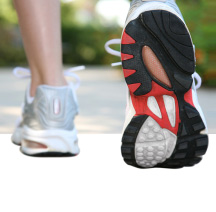How’s Your Gait?
 by Bob Forman
by Bob Forman
It is pretty amazing when you think about all the body surface area we have and how little of it actually makes contact with the ground when we are standing and even less when in motion. That relatively small contact area, to be more specific the bottom of our feet, can have a pretty significant influence on how we feel.
Gait, according to Merriam-Webster, is a manner of walking or moving on foot. It plays a vital role in keeping us aligned from our feet all the way up to our head. The normal gait is characterized by each foot striding forward, landing on the outer part of the heel, rolling in slightly (known as pronation) and then pushing off with the big toe.
An individual’s gait or stride is often taken for granted and not really thought about much, although it should, as an improper gait can increase the potential for both acute injury and chronic aches and pain. We are talking all the way up the body from the feet to the knees, hips, lower back, shoulders, neck, and head. If you have been hampered by an ache or pain in one or more of these areas and it has been difficult to find the cause, take a look at your gait.
The most common gait issue is over pronation or an excessive rolling in of the foot and ankle during the stride. This results in a wearing of the inner or medial aspect of the underside of the shoe. Less common is under pronation, otherwise known as supination. This is characterized by not enough rolling in of the ankle and a wear pattern on the outer part of the sole, as the individual tends to stay on the lateral or outside part of the foot.
People with flat feet tend to over pronate as do people who toe out when they walk. On the other extreme, people with high-arched feet tend to supinate. These are not requirements, however, as people with neutral feet can go either way. It is not uncommon to have a normal gait on one foot and either over pronate or supinate on the other.
The long term impact on the body from either gait pattern has been researched extensively. In this one example note how the left skeleton is out of balance due to over pronation of the left foot. As you can see, the rolling in of the foot causes misalignment throughout the entire body. When the body is misaligned, functionality is impaired and unwanted stress is placed on the muscles and joints. This can impact efficiency of movement and cause both acute and chronic pain.
Running shoes, which are ideal for walking as well, have long had the technology to help negate improper gait by either providing motion control or more flexibility. The former providing over pronators with more medial support to prevent the excessive rolling in of the foot while the latter offering more cushioning to facilitate pronation for those who supinate.
Which are you? Checking the wear pattern on your shoes that you have worn for awhile can give you a hint, although sometimes it is tough to tell. Having a gait analysis by someone who is trained in identifying gait patterns is a good route to take. They can assess if you have improper gait, what type of gait you have, and then recommend a particular style of shoe to look for on your next purchase. This is good information to know, especially if you do quite of bit of walking/running.
By the way, if you have been wearing the same shoes to walk or run in for the past year or longer, you are asking for problems. Most running shoes, if worn on a regular basis, should be replaced every 6 to 8 months as the support they provide tends to diminish with the wear. An ounce of prevention may save you some big bucks down the road and aid in keeping you pain-free.
The weather has warmed up and folks are once again outdoors. Make sure you have the proper footwear as this will help in maintaining body alignment, which will promote better movement patterns while reducing the potential for injury.
Bob Forman is the manager at The Fitness Center at Kernersville.

